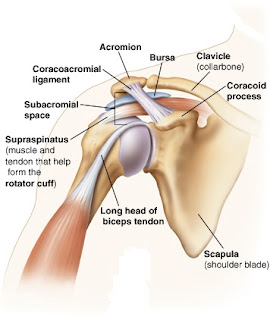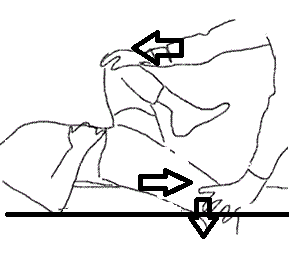'knots in the muscles'
THE TRIGGER POINTS
 |
| image from google |
You might be thinking about how knots
can even be growing inside your muscles. Is this possible for a muscle to
develop knots inside? Well, Yes! These things are for real. You do sometimes
have knots in your muscles usually called as the MYOFASCIAL TRIGGER POINTS, in
medical terms.
Recently I have been doing a research
as a partial fulfillment for my BPT course, and I found some really good
results and learnt a lot of new concepts. My research was based on the
management of trigger points, a comparative study between two treatment
protocols. So, here I decided to share with you my experience throughout the
research and also I’ll try to explain you in brief what these points actually
are.
TRIGGER POINTS (Tying up of the muscles).
Trigger points (muscle knots) are the
small hyperirritable nodules often found in a tight band of muscle fibers. These
knots are sometimes palpable as a considerably big round knot found deep inside
the muscle and sometimes they are just tender points that hurt when we apply a
deep pressure over them. These knots are developed due to micro trauma inside
the muscle, repetitive injury to the muscle and overuse. Almost all of us these
days are working on screens which makes us to attain certain position which are
harmful for our body. Trigger points are a result of such postures that we are
living in for prolonged hours.
Here, i have tried to explain you about the structure of the muscle fibers before and after the formation of trigger points.
 |
| image form google |
The muscle becomes tight and stiff,
forming areas which are hyperirritable and tender. These areas are deficient of
metabolites. They lack oxygen and become ischemic. The influence of these
points affect the surrounding muscle fibers as well. And the adjacent muscle
fibers become stretched due to formation of knots between these two stretched
fibers. The affected muscle is shortened in length, due to the inflammation of
one point in the entire muscle length.
 |
| Myofascial Pain Syndrome due to trigger points David G. Simons, M.D. |
These trigger points can be of two types:
1. Active:
These are the points which are “pain expressive”,
which means, these causes pain, muscle tightness, spasm and referred pain (pain
reaching to other areas as well). This simply means that you need not go on a
hunt to search where the trigger points actually are inside your body, they
make their presence noticeable on their own by the symptoms.
2. Latent:
These points does not express pain. They
are the hidden ones. They scream only when you irritate them by compressing
deeply.
The micro trauma causes release of free calcium ions and increased metabolism in the affected region, causing several metabolic changes.
 |
| Myofascial Pain Syndrome due to trigger points David G. Simons, M.D. |
I randomly selected 30 patients, both
male and female of age ranging between 18-60 years fulfilling the inclusion criteria.
I chose the upper trapezius muscle fibers (the muscle at the back and sides of
your neck and above shoulders) for study. This is found to be the “knottiest” muscle
by earlier studies and is more prone to development of nodules.
The inclusion criteria being:
-
Presence
of at least 1 knot on any side.
-
Presence
of palpable knot or tender point.
-
Presence
of both active and latent trigger points.
-
Presence
of tight muscle band.
I excluded the patients with any injury, surgery, tumors or lesion to the area.
Identifying the trigger points (Are you knotted up)?
So, how can you identify, if you are
a victim of these knots. The simple symptom check can make it easier for you to
find them inside your muscles.
-
You
experience pain around the muscle, which after some time reaches other areas.
-
Your
muscle is tight and it is difficult for you to perform that particular
movement.
-
When
pressure is applied to that point, you experience a ‘jump sign’. That means you suddenly jump off the couch due to sudden pain.
-
The
pain is often aching, bumping and burning.
-
You
observe a spherical ball like structure in the muscle when you press deeply.
I chose three major critera to identify the trigger point presence in patients. The visual analogue scale (VAS), which helped me determine the severity of pain in the patient. The Range of Motion using universal Goniometer, a device which helped me to measure the values of neck movements and Neck Disability Index scoring (NDI), which told me about the affected functions of daily life activities of the patient.
Trigger point management (Getting rid of muscle knots).
I chose two treatment protocols for
my patients:
1. Phonophoresis :
Phonophoresis is a method used to
relieve pain, with the help of topical agents. These topical agents are
medicines which are applied to the skin topically and are absorbed inside the
muscles with the help of ultrasound therapy. I used diclofenac gel (volini©) which is an NSAID (non-steroidal anti-inflammatory drug),
used to relieve local inflammation and pain.
2. Ultrasound therapy:
This is a physiotherapeutic
intervention used to enhance the healing the tissues deep inside, by increasing
the local blood supply which is already deficient in the area of trigger point.
3. Stretching:
This is a form of flexibility
exercise which is used to increase the range of motion by increasing the muscle
flexibility and improves the movement of the particular affected area.
4. Hot fomentation:
There is always a dilemma between ice
and heat when it comes to trigger point. Both are effective in relieving
symptoms, you can’t really prove which one is better. I decided to choose hot
fomentation to provide sedative heating effect along with reduced stiffness in
the muscle. Moist heat is better to use in case of muscle stiffness.
5. Interferential current:
IFT, is used to reduce localized pain
in the muscle. These low frequency currents are produced deep inside the muscle
by combining two medium frequency currents. And these are found to be effective
in pain relief.
There are many more treatment methods
which are used to treat myofascial trigger points. These are a few which I chose
for my patients.
Trigger points have become common
now, it was not difficult for me to find patients suffering from these muscle
knots. I found out, that a major cause behind formation of these knots inside
the muscle is ‘posture’. Long hours of mobile use, computer use, and desk work
etcetera makes you more prone to the muscle knots.
Along with these treatment methods,
try to improve your working habits and posture. So that you can eliminate the
further risk and exacerbations.
What I found, was that the method of
phonophoresis was more effective as compared to ultrasound therapy, the nodules
were dissolving slowly. You will have to be patient for the nodules to disappear
as it takes quite a long duration for them to vanish.
“It doesn’t matter how slow you go, as long as you do
not stop”.
As the knots reduces, the range of motion
improves. The stretching was helping more to increase the range to the normal
values. Hot fomentation reduces stiffness considerably and helps in increasing
the elasticity of muscle a bit so that it’s easy for the muscle to stretch,
whether actively or passively. So, everything is kind of inter-related. One effects
the results of the other and the protocol as a whole works effectively for the
condition.
“Your body’s ability to heal is greater than anyone has permitted you to
believe”.
If you can relate with this article
and feel like you too might have these, consult your physiotherapist now. If
you leave these knots unnoticed, the condition might worsen and cause several
musculoskeletal difficulties and restrict your daily activities.
Myofascial trigger points are often one of the
most common reasons behind pain in your body. Once the treatment is done, and
the knot is disappeared, the muscle is reverted back to its original length. And
the symptoms therefore, are eventually reduced.
I am still in a process of learning and i am trying to discover more about myofascial trigger points. until I come up with more findings, i hope this information helps you identify your problem.
Take care,
Jasrah Javed




Comments